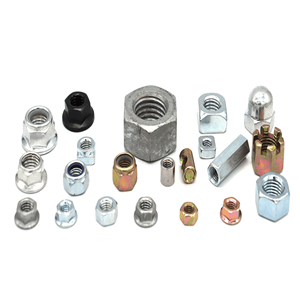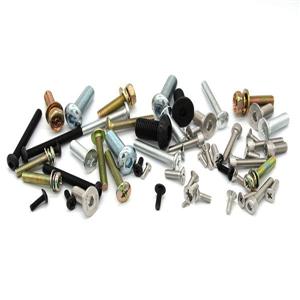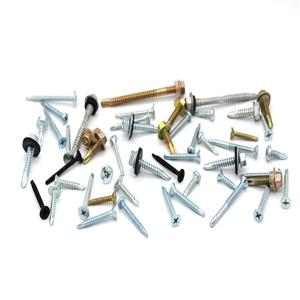Talking about the influencing factors of bolt tensile test ...
1 Definition
The tensile strength of a bolt refers to the maximum tensile force that the bolt can withstand before being broken in the axial direction. It is the critical value for the transition from uniform plastic deformation to locally concentrated plastic deformation, and it is also the maximum load under static tensile ability. The yield strength of a bolt refers to the phenomenon that the stress does not increase or fluctuates within a small range during the tensile test of the bolt, but the phenomenon of rapid increase in strain occurs.
2 Standard basis
The national standard on which the mechanical properties of bolts are usually tested is GB / T3098.1-2010 "Mechanical Properties of Fasteners Bolts, Screws and Studs". This standard stipulates that the tensile test shall be performed in accordance with the requirements of GB / T 228. The currently valid standard is GB / T 228.1-2010 "Tensile Tests for Metallic Materials-Part 1: Room Temperature Test Method". The tests discussed in this article are all tested against the FF test series, ie finished bolts, specified in GB / T 3098.1-2010, excluding the MP series, which is the fastener material test.
3 influencing factors
3.1 Human influence
The quality of inspectors is a very important influencing factor, which penetrates into all links. Including the selection and understanding of standards, the operation of the test process, the calculation and processing of inspection data after the test, etc. have personnel influence. Errors in any of these links will affect the accuracy of the test results. Therefore, it is necessary to improve the quality of inspection personnel and reduce human influence.
3.2 Impact of equipment
(1) Periodic verification of inspection equipment
The tensile testing machine must be checked regularly, and can only be used after passing the test. The verification cycle is usually one year. If equipment movement, relocation, maintenance, transformation, and other changes occur to the existing state of the equipment during the period, the equipment should be verified after the equipment is stabilized and before the equipment is used. GB / T3098.1-2010 makes requirements for the equipment, that is, the tensile testing machine should meet the requirements of GB / T 16825.1.
(2) Applicability of equipment range
Generally, when the test data is about 2/3 of the full range of the tensile tester, the data accuracy is relatively highest. Therefore, the appropriate equipment should be selected according to the tensile limit force value of the bolt to be inspected. If the measuring range of the equipment is not selected properly, it will easily cause a certain deviation and affect the accuracy of the data.
(3) Equipment preheating
Before the test starts, the equipment should be preheated and run a few times without load to make the equipment in a better state to be checked to reduce errors.
(4) Fixture
GB / T 3098.1-2010 makes requirements for fixtures. Tensile test machine fixture: hardness should be greater than or equal to 45HRC. Matching screw clamp: the hardness should be greater than or equal to 45HRC. Due to the different surface treatment methods of fasteners, the thread accuracy of internal thread clamps is also different. The thread accuracy of internal thread clamps should reach 6H, 6AZ, and 6AX accordingly. If the hardness of the fixture is too low, the bolt cannot be effectively fixed during the tensile test, and the fixture may be damaged. If the accuracy of the internal thread is low, the bolt may not be screwed into the fixture. Impact test.
3.3 Effect of the sample
(1) During the inspection process, tests shall be performed on the samples after the basic dimensions, thread accuracy and other items that do not damage the samples have been performed.
(2) Bolts without surface defects should be selected for testing. If there are quality defects on the surface, the results of the tensile test will be seriously affected.
3.4 Impact of test methods
(1) Correctness of selection criteria
If the test criteria cannot be selected correctly, all subsequent work is wrong. Inspections must be carried out in accordance with the product's stated standards, and must not be taken for granted. To confirm the validity of the standard. Bolt products have their particularities. Some bolts are used in old equipment or for other reasons, they must be produced according to the expired standard. At this time, the inspection shall be carried out according to the standards explicitly stated by the product, otherwise the judgment of the inspection results will be affected.
(2) Cognition and understanding of standards
It is necessary to read the standard carefully and understand the requirements in the standard accurately, otherwise it will not be able to perform the test in full compliance with the standard requirements, fail to operate in accordance with standard procedures, and affect the inspection results.
(3) Standardization of test process operation
First, the clamping of the sample should choose the internal thread clamp with the same specifications as the bolt to be inspected. Different types of bolts have different requirements when installing fixtures. Too short a turn-on length will cause the sample to loosen or detach from the fixture during the tensile process; un-tightened length is too short, which affects the effective fracture position of the sample and directly affects test results. GB / T 3098.1-2010 has specific regulations on how to insert the specimen into the clamp, as follows:
Bolts: The bolts to be inspected should be screwed into the internal thread clamp. The effective screwing length should be ≥1d, and the unthreaded length should be ≥1d.
Studs: Both ends should be screwed into the internally threaded clamp. The effective screw-in length should be ≥1d, and the un-threaded length should be ≥1d.
Bolts with short-threaded bolting structure: untwisted length should be <1d (d is the nominal diameter of the bolt).
The second is to clamp the internal thread clamp in the clamp of the tensile test machine. It must be noted that the chucks of the upper and lower internal thread clamps must be vertically clamped into the clamp of the tensile test machine to maintain the coaxial state. Otherwise, eccentric force will be generated on the test piece, which will cause the test force to be axially offset from the test piece and affect the test result. The chuck of the internal thread clamp is generally cylindrical, so the clamp of the tensile tester should be a V-shaped clamp, and its size should also match the chuck size of the internal thread clamp. At the same time, the tensile machine fixture should not produce bending stress on the test piece, otherwise it will affect the test results.
The third is the stretching speed. The moving speed of the tension tester chuck shall be ≤25mm / min until it is broken. For bolts that can test the yield strength, too high speed can easily lead to large yield strength results, and sometimes it can also result in failure to test the yield strength, which affects the test results.
(4) Accuracy of calculation of results after the test
The tensile strength and yield strength are calculated from the force values obtained from the tests. GB / T 3098.1-2010 stipulates the formula as follows:
Rm = Fm / As (1)
In the formula: Rm — tensile strength, MPa; Fm — ultimate load, kN; As — nominal area of bolt, mm2.
R el = Fel / As (2)
In the formula: R el ——lower yield strength, MPa; Fel —— ultimate load, kN; As —— nominal area of bolt, mm2 (can be found in GB / T 3098.1-2010).
The Fm and Fel value records should be accurate, otherwise the calculation result will be wrong; the incorrect lookup of the table will also cause the calculation result to be wrong.
3.5 Environmental impact
GB / T 3098.1-2010 and GB / T 228.1-2010 both stipulate that the test is generally performed in a laboratory at 10 ° C to 35 ° C. If the ambient temperature is too low, the body-centered cubic crystal structure metal material bolts will increase yield strength as the temperature decreases, while the face-centered cubic crystal structure metal material bolts will not change much; if the ambient temperature is too high, the bolts ’ Yield strength decreases with increasing temperature. Therefore, the laboratory should maintain a suitable temperature to avoid affecting the test results.
4 Conclusion
To sum up, in the process of bolt tension test, we must try to avoid these factors as far as possible to reduce the error of the test results and improve the accuracy.




